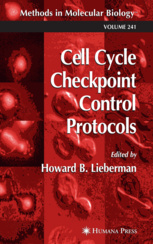Description
Cell Cycle Checkpoint Control Protocols, Softcover reprint of hardcover 1st ed. 2004
Methods in Molecular Biology Series, Vol. 241
Coordinator: Lieberman Howard B.
Language: English
Subject for Cell Cycle Checkpoint Control Protocols:
Cell Cycle Checkpoint Control Protocols
Publication date: 11-2010
376 p. · 15.2x22.9 cm · Paperback
Publication date: 11-2010
376 p. · 15.2x22.9 cm · Paperback
Cell cycle checkpoint control protocols (methods in molecular biology, Vol. 241)
Publication date: 11-2003
376 p. · 15.5x23.5 cm · Hardback
Publication date: 11-2003
376 p. · 15.5x23.5 cm · Hardback
Description
/li>Contents
/li>Comment
/li>
The field of cell cycle regulation is based on the observation that the life cycle of a cell progresses through several distinct phases, G1, M, S, and G2, occurring in a well-defined temporal order. Details of the mechanisms involved are rapidly emerging and appear extraordinarily complex. Furthermore, not only is the order of the phases important, but in normal eukaryotic cells one phase will not begin unless the prior phase is completed successfully. Che- point control mechanisms are essentially surveillance systems that monitor the events in each phase, and assure that the cell does not progress prematurely to the next phase. If conditions are such that the cell is not ready to progress?for example, because of incomplete DNA replication in S or DNA damage that may interfere with chromosome segregation in M?a transient delay in cell cycle progression will occur. Once the inducing event is properly handled? for example, DNA replication is no longer blocked or damaged DNA is repaired?cell cycle progression continues. Checkpoint controls have recently been the focus of intense study by investigators interested in mechanisms that regulate the cell cycle. Furthermore, the relationship between checkpoint c- trol and carcinogenesis has additionally enhanced interest in these cell cycle regulatory pathways. It is clear that cancer cells often lack these checkpoints and exhibit genomic instability as a result. Moreover, several tumor suppressor genes participate in checkpoint control, and alterations in these genes are as- ciated with genomic instability as well as the development of cancer.
Induction and Detection of Changes in cell Cycle Progression.- Methods to Induce Cell Cycle Checkpoints.- Methods for Synchronizing Mammalian Cells.- Enrichment of Cells in Different Phases of the Cell Cycle by Centrifugal Elutriation.- Analysis of the Mammalian Cell Cycle by Flow Cytometry.- Methods for Detecting Cells in S Phase.- Yeast Cell Synchronization.- Analysis of the Budding Yeast Saccharomyces cerevisiae Cell Cycle by Morphological Criteria and Flow Cytometry.- Analysis of the Fission Yeast Schizosaccharomyces pombe Cell Cycle.- Analysis of Genes Involved in Checkpoint Control.- Strategies to Isolate Evolutionarily Conserved Cell Cycle Regulatory Genes.- Microarray Approaches for Analysis of Cell Cycle Regulatory Genes.- Using the Yeast Genome-Wide Gene-Deletion Collection for Systematic Genetic Screens.- Gene Targeting in Cultured Human Cells.- Use of In Vivo Gap Repair for Isolation of Mutant Alleles of a Checkpoint Gene.- In Vitro Mutagenesis to Define Functional Domains.- Use of Gene Overexpression to Assess Function in Cell Cycle Control.- Histone Acetylation/Deacetylation As a Regulator of Cell Cycle Gene Expression.- Analysis of Proteins Involved in Checkpoint Control.- Cataloging Proteins in Cell Cycle Control.- Multidimensional Proteomic Analysis of Proteolytic Pathways Involved in Cell Cycle Control.- Purification and Identification of Protein Complexes That Control the Cell Cycle.- Xenopus Cell-Free Extracts to Study DNA Damage Checkpoints.- Protein-Protein Interactions.- Detection of Kinase and Phosphatase Activities.- Monitoring Changes in the Subcellular Location of Proteins in S. cerevisiae.- Chromosomes and the Cell Cycle.- Chromosomal Changes and Cell Cycle Checkpoints in Mammalian Cells.- Detecting the Influence of Cell Cycle Regulatory Proteins on Human Telomeres.- Monitoring Spindle Assembly and Disassembly in Yeast by Indirect Immunofluorescence.
Includes supplementary material: sn.pub/extras
© 2024 LAVOISIER S.A.S.
These books may interest you

Models of Cellular Regulation 85.25 €



